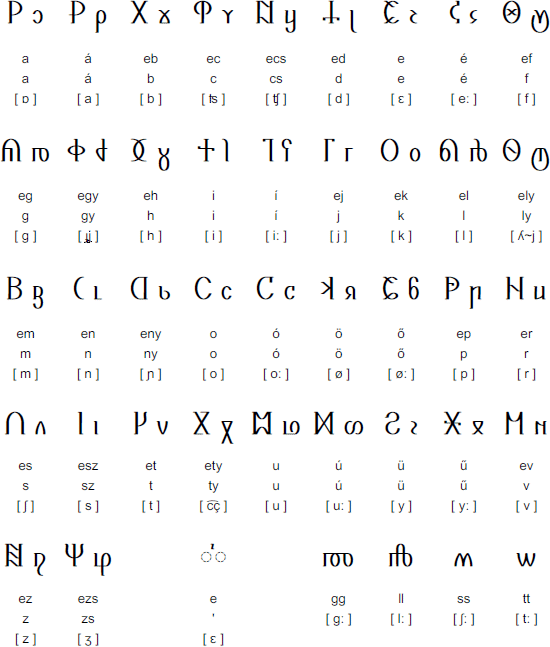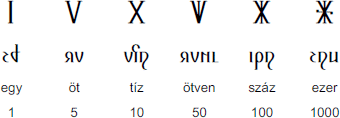Gyorsrovás

Gyorsrovás (in English: Quick Runic or Runic Shorthand)
was developed by Attila Répai as an alternative way to write Hungarian using
a rounded style of the Hungarian rovás
(used in books between the 16th and 19th centuries).
The reason of creating this alphabet was to make the Rovás handwriting
faster and easier. For this purpose the original letters were
simplified or reduced to their most important part. Another advantage
of Gyorsrovás over the Latin alphabet is that it reduces the overall
length of a Hungarian text as it doesn’t contain digraphs and words can
be abbraviated.
![]()
Notable features
- Used to write: Hungarian
- Type of writing system: alphabet
- Direction of writing: left to right in horizontal lines. It can also be
written from right to left, but in this case all characters are to be mirrored. - All small letters can be written down with one continuous line, without
lifting the pen. - There are four ligatures for long consonants to save on the length of the words.
- The most frequent vowel, E (8%) can either be replaced with
a diacritic mark or be completely omitted. But it’s obligatory to write
E in initial or final position or between two identical consonants.

- Some frequent linking words can be abbreviated to one
letter: és > s, az > z, egy > gy, hogy > h.
Gyorsrovás alphabet

Notes
- There are no letters for non-Hungarian letters such as Q, X, Y, W. Words
containing them are to be transliterated phonetically, replacing these letters
with KV, KSZ, I or J, V.
Numerals

Punctuation
Most of the punctuation marks are identical with the English ones. These are the exceptions:

Sample texts in Hungarian
Without abbreviations

Transliteration
Minden emberi lény szabadon születik és egyenlő
méltósága és joga van. Az emberek, ésszel
és lelkiismerettel bírván, egymással szemben
testvéri szellemben kell, hogy viseltessenek.
(Az Emberi Jogok Egyetemes Nyilatkozata, 1. cikk)
With diacritical E’s

Transliteration
Mind’n emb’ri lény szabadon szül’tik és egy’nlő
méltósága és joga van. Az emb’r’k, éssz’l
és lelkiism’r’tt’l bírván, egymással sz’mb’n
t’stvéri sz’ll’mb’n k’ll, hogy vis’lt’ss’n’k.
(Az Emb’ri Jogok Egy’t’m’s Nyilatkozata, 1. cikk)
With abbreviations, medial E’s are omitted

Handwritten

Transliteration
Mindn embri lény szabadon szültik s egynlő
méltósága s joga van. Z embrk, ésszl s
lelkiismrttl bírván, egymással szmbn tstvéri
szllmbn kll, h visltssnk.
(Z Embri Jogok Egytms Nyilatkozata, 1. cikk)
Translation
All human beings are born free and equal in dignity and rights. They
are endowed with reason and conscience and should act towards one
another in a spirit of brotherhood.
(Universal Declaration of Human Rights, Article 1)
